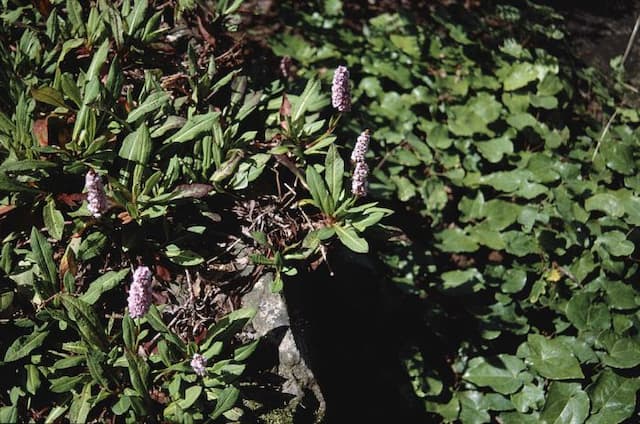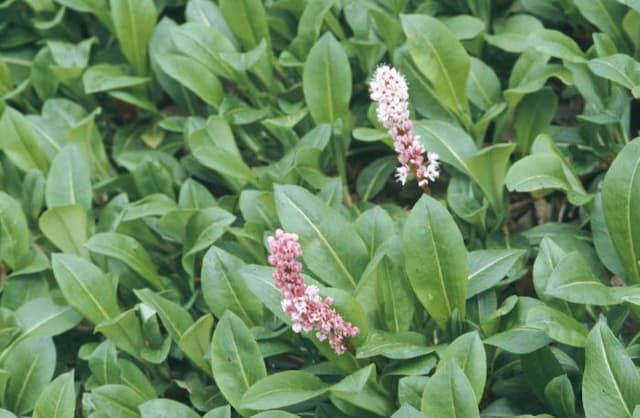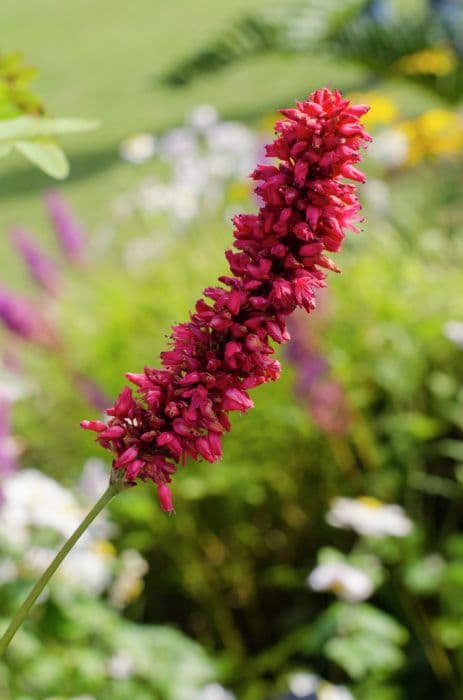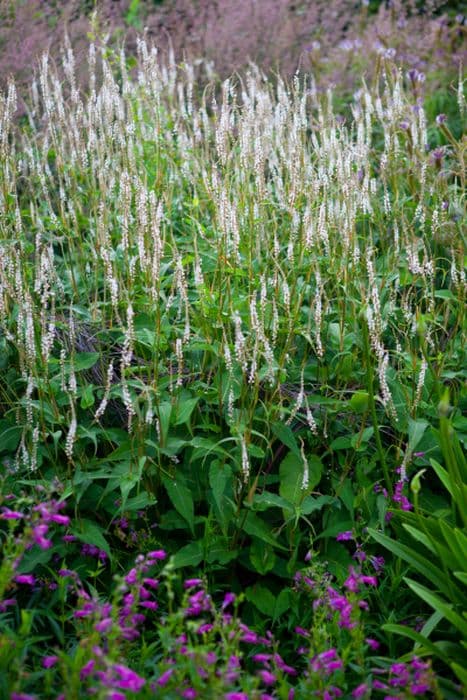Red bistort Persicaria amplexicaulis Taurus = 'Blotau'
![red bistort [Taurus]](/_next/image?url=https%3A%2F%2Fplants-admin.emdemapps.com%2Fimages%2Fplants%2F%2Fimages%2F604b548be7841.png&w=3840&q=75)
ABOUT
The plant commonly known as "Red Bistort" or "Mountain Fleece" is a vigorous, clump-forming perennial known for its striking and colorful appearance. The foliage of Red Bistort consists of large, bright green leaves that are broadly lance-shaped and somewhat glossy, often with a slightly puckered texture. During the flowering season, Red Bistort produces a profusion of slender, spike-like flower stalks. The blooms are densely arranged in elongated clusters called spikes, carried high above the foliage. The flowers themselves are small yet numerous, each a delicate, tubular shape typically a rich and fiery red color, giving the plant a vibrant and dramatic look. These flower spikes can add a vertical dimension to the garden, creating an eye-catching display as they sway gently in the breeze. The blooming period is quite lengthy, bringing a long season of interest to the garden. After the flowers have finished, the plant still provides visual interest with its attractive leaves.
About this plant
 Names
NamesFamily
Polygonaceae
Synonyms
Red Bistort, Mountain Fleece, Taurus Bistort
Common names
Persicaria amplexicaulis 'Taurus'.
 Toxicity
ToxicityTo humans
Red bistort is not commonly known to be toxic to humans. There is limited information on this specific variety 'Blotau', but in general, Persicaria amplexicaulis doesn’t contain compounds that are harmful to humans when touched or ingested in small amounts. However, as with any plant, it is recommended to avoid eating it unless it is known to be safe, and to observe for any signs of allergic reactions or gastrointestinal distress if accidental ingestion occurs. If any symptoms are observed, it would be advisable to consult a medical professional.
To pets
Red bistort is not commonly known to be toxic to pets. As with the information for humans, there is limited specific data regarding the 'Blotau' variety, but Persicaria amplexicaulis, in general, does not contain known toxins that harm pets. While it should not be a problem if pets occasionally nibble on the leaves, ingestion of large amounts of any plant material can potentially cause mild stomach upset due to the physical irritation of the gastrointestinal tract. If a pet shows signs of distress after eating this plant, such as vomiting or diarrhea, contacting a veterinarian is recommended.
 Characteristics
CharacteristicsLife cycle
Perennials
Foliage type
Deciduous
Color of leaves
Green
Flower color
Red
Height
3-4 feet (90-120 cm)
Spread
2-3 feet (60-90 cm)
Plant type
Herb
Hardiness zones
5
Native area
Himalayas
Benefits
 General Benefits
General Benefits- Attracts pollinators: The flowers of Bistort 'Taurus' provide a rich source of nectar, attracting bees, butterflies, and other beneficial insects.
- Low maintenance: Once established, Bistort 'Taurus' requires minimal upkeep, making it a hassle-free addition to the garden.
- Drought tolerance: This plant can withstand periods of dry weather, reducing the need for frequent watering.
- Deer and rabbit resistant: Its foliage is not favored by deer and rabbits, helping to prevent grazing damage in the garden.
- Long blooming period: Bistort 'Taurus' offers a long flowering season, producing blooms from mid-summer to early autumn.
- Erosion control: The dense growth habit of Bistort 'Taurus' helps stabilize soil, preventing erosion on slopes or banks.
- Ornamental value: With vivid red flowers and attractive foliage, this plant adds visual interest and color contrast to garden beds and borders.
- Hardiness: It thrives in a variety of climates and is cold hardy, making it suitable for many different gardening zones.
- Habitat enrichment: By adding Bistort 'Taurus' to the landscape, you can contribute to local biodiversity and support a healthy ecosystem.
- Versatility: This plant can be used in various garden designs, including cottage gardens, wildlife gardens, and as part of mixed perennial borders.
 Medical Properties
Medical PropertiesThis plant is not used for medical purposes.
 Air-purifying Qualities
Air-purifying QualitiesThis plant is not specifically known for air purifying qualities.
 Other Uses
Other Uses- Persicaria amplexicaulis 'Taurus', commonly known as Red Bistort, can be used to create a natural dye for fabrics, yielding shades of tan to brown depending on the mordant used.
- The plant's robust stems can be incorporated into rustic crafts and weaving projects, lending a unique texture and natural color to handmade baskets.
- Red Bistort's dense floral spikes and foliage can serve as a living mulch, providing ground cover that suppresses weeds while adding visual interest to the garden.
- The plant can be used in educational settings, such as biology classes, to study pollination and plant growth habits, as it is attractive to pollinators.
- Dry arrangements and potpourri can include the dried flowers and seeded heads of Red Bistort for long-lasting natural decor.
- Garden photographers and artists can use Red Bistort as a subject for developing composition skills due to its striking appearance.
- The plant's leaves and stems can be used as a natural green fertilizer or composted to create a nutrient-rich soil conditioner for gardens.
- Red Bistort can be planted near ponds or water features to create a naturalized, wild setting that blends with waterside environments.
- The flowers of Red Bistort can be used to provide a natural, subtle scent to linen closets when dried and placed in sachets.
- Botanical illustrators can use Red Bistort as a model for drawing or painting, capturing its distinctive flower spikes and leaf structure.
Interesting Facts
 Feng Shui
Feng ShuiThe plant Persicaria amplexicaulis is not used in Feng Shui practice.
 Zodiac Sign Compitability
Zodiac Sign CompitabilityThe plant Persicaria amplexicaulis is not used in astrology practice.
 Plant Symbolism
Plant Symbolism- Endurance: The Persicaria amplexicaulis, commonly known as Red Bistort or Mountain Fleece, has a robust and resilient nature, symbolizing the ability to endure adverse conditions and persevere over time.
- Versatility: Given its adaptability to a range of soil types and its tolerance of both sun and partial shade, the Red Bistort represents versatility and flexibility in various environments.
- Attraction: With its bright, elongated flower spikes that attract pollinators such as bees and butterflies, the Red Bistort can symbolize an alluring and magnetic quality, drawing in positivity and interest.
- Growth: The plant's tendency to spread and cover ground effectively signifies continuous growth, personal development, and expansion in one's life journey.
 Water
WaterThe Red Bistort should be watered regularly, ensuring that the soil remains consistently moist but not waterlogged. During the growing season, typically once a week should suffice, providing about 1 gallon of water per week for mature plants. Increase watering frequency during hot and dry periods to maintain soil moisture. During the winter, reduce watering as plant requirements decrease. Always check the top inch of soil for dryness before watering to avoid overwatering.
 Light
LightRed Bistort thrives in a position where it receives full sun to partial shade. The best spot for this plant is one that offers direct sunlight for at least part of the day, but also some shelter from the intense midday sun. Areas with morning sunlight and afternoon shade are ideal to encourage vigorous growth and flowering.
 Temperature
TemperatureRed Bistort is hardy and can tolerate a range of temperatures but prefers to be grown in conditions where the temperature remains between 50°F and 70°F. The plant can survive minimum temperatures down to approximately 10°F and maximum temperatures up to around 85°F. Ideal temperatures encourage lush foliage growth and vibrant blooms.
 Pruning
PruningPruning Red Bistort is essential to maintain its shape and encourage denser growth. The best time to prune is in late winter or early spring before new growth starts. Cut back the old stems to about 4-6 inches above ground level to promote fresh growth. Additionally, deadheading spent flowers during the blooming season can encourage further blooms.
 Cleaning
CleaningAs needed
 Soil
SoilRed Bistort 'Taurus' prefers fertile, moist soil with good drainage and a pH ranging from 6.0 to 7.0. A mix of garden soil, compost, and peat or leaf mold will provide the optimal environment with adequate aeration and nutrients.
 Repotting
RepottingRed Bistort 'Taurus' is a perennial that typically does not require frequent repotting. It can be divided every 3 to 4 years to rejuvenate the plant and manage its size.
 Humidity & Misting
Humidity & MistingRed Bistort 'Taurus' does well in average garden conditions and does not require specific humidity levels; however, it appreciates a slightly humid environment that mimics its natural habitat.
 Suitable locations
Suitable locationsIndoor
Ensure bright, indirect light and well-draining soil.
Outdoor
Plant in partial shade, moist soil, and shelter from winds.
Hardiness zone
4-7 USDA.
 Life cycle
Life cycleThe Persicaria amplexicaulis Taurus, commonly known as Red Bistort 'Taurus', begins its life cycle as a seed, which germinates in spring when soil temperatures rise and moisture is abundant. Once germinated, the seedling emerges and establishes a root system, while developing its first leaves to begin photosynthesis. As it matures into a young plant, Persicaria amplexicaulis 'Taurus' develops a clumping habit with robust stems and large leaves, growing actively during the spring and summer months. Flowering typically occurs in mid to late summer, presenting elongated spikes of densely packed, deep red flowers that attract pollinators such as bees and butterflies, facilitating cross-pollination. Following pollination, seeds are produced which can be dispersed by wind, water, or animals, completing the reproductive stage. As a hardy perennial, Persicaria amplexicaulis 'Taurus' will die back to the ground at the onset of winter, with its root system remaining dormant until the next spring, when the cycle begins anew.
 Propogation
PropogationPropogation time
Spring-Early Summer
The Persicaria amplexicaulis 'Taurus', commonly known as Red Bistort or Fleece Flower, can be propagated most effectively by division. This method is typically carried out in the spring, just as the plant begins to show new growth. To propagate by division, carefully lift the clump from the ground and use a sharp spade or knife to cut it into smaller sections, ensuring that each section has a piece of the root system and several shoots. Replant the divisions immediately at the same depth they were originally growing, spacing them about 12 to 15 inches (approximately 30 to 38 centimeters) apart to allow ample room for growth. Water the new plants thoroughly to settle the soil around the roots and to help establish them in their new location. This method of propagation is quick and effective, often resulting in new plants that will bloom within the same season.









